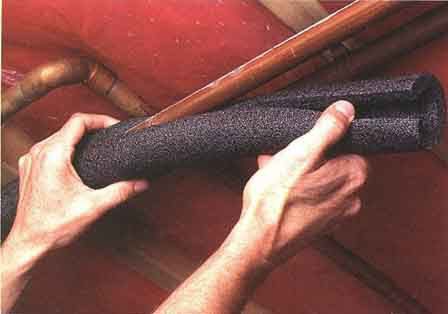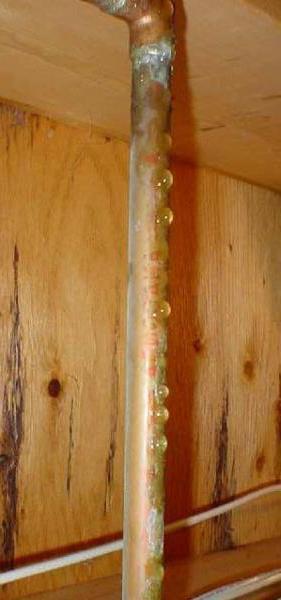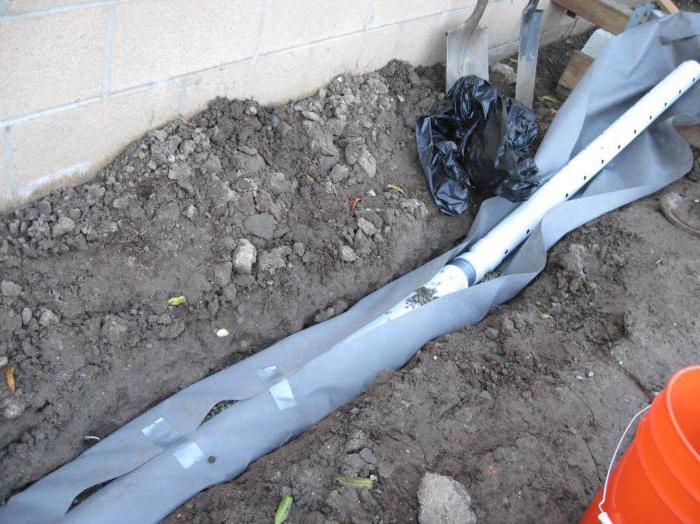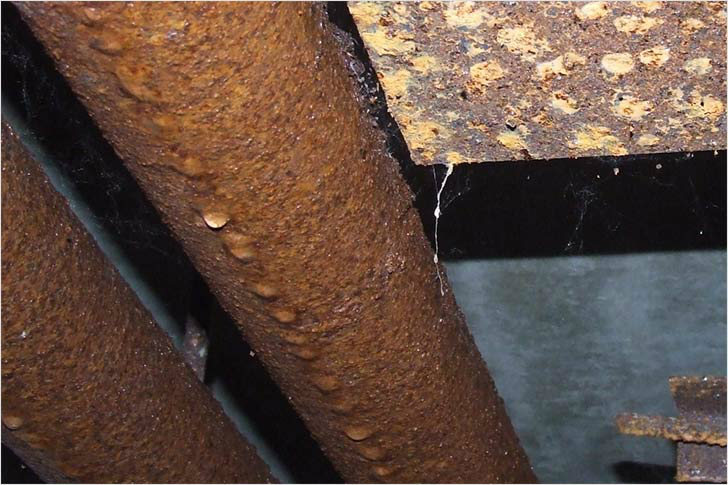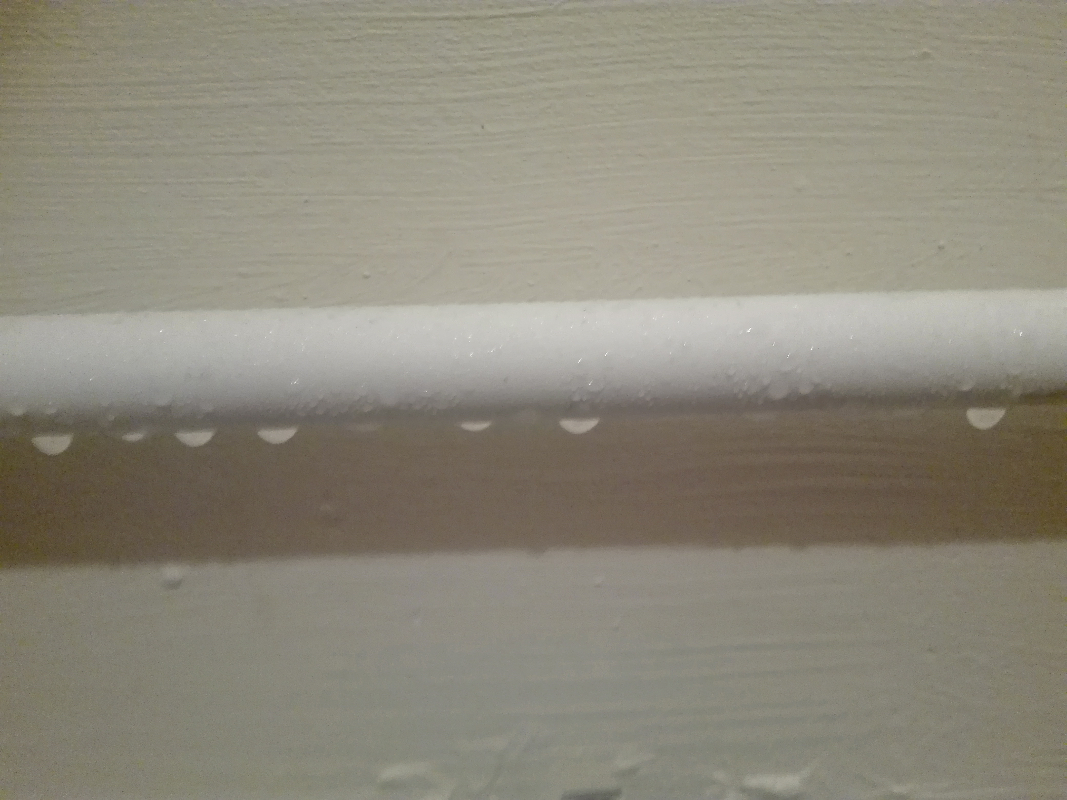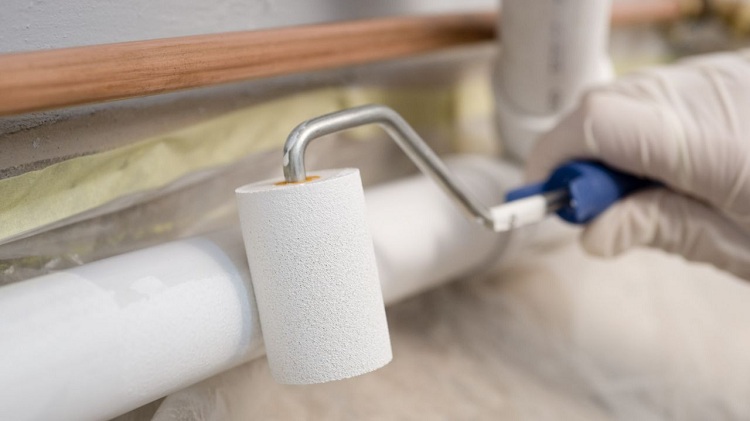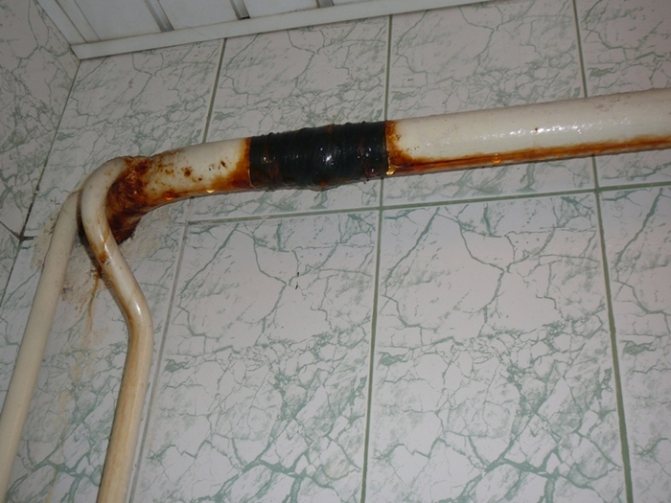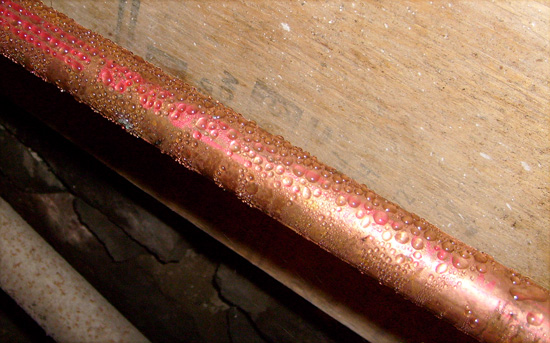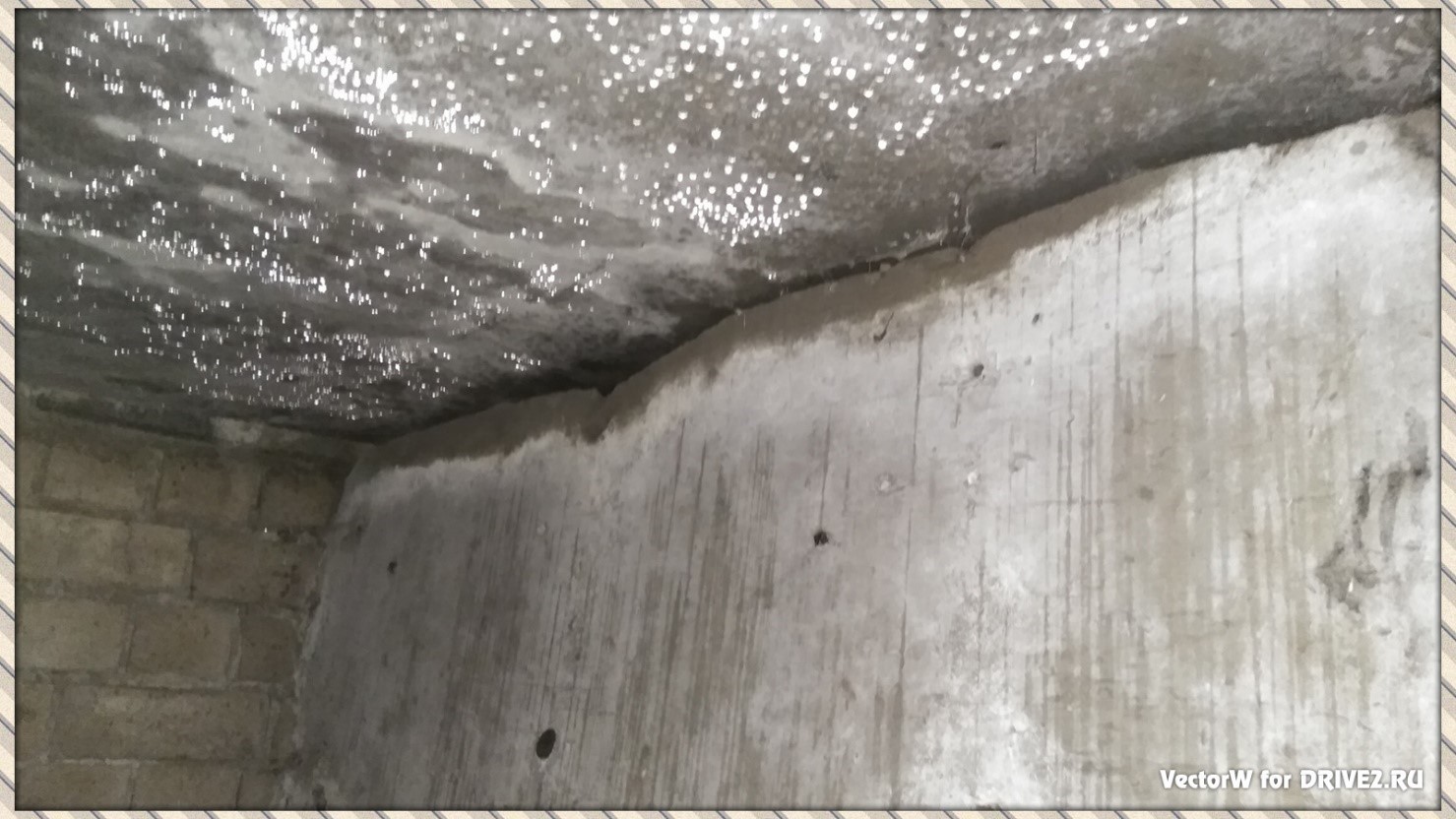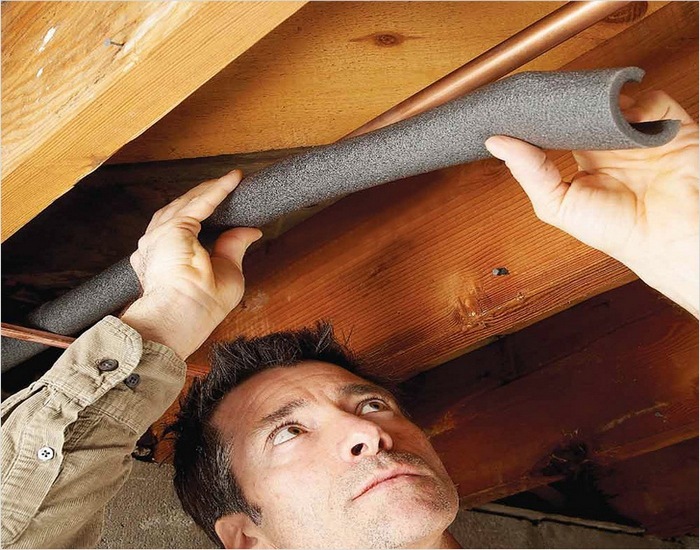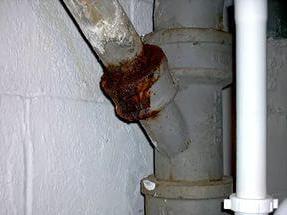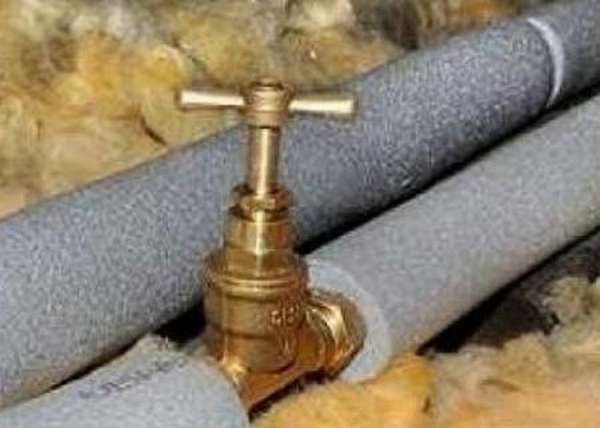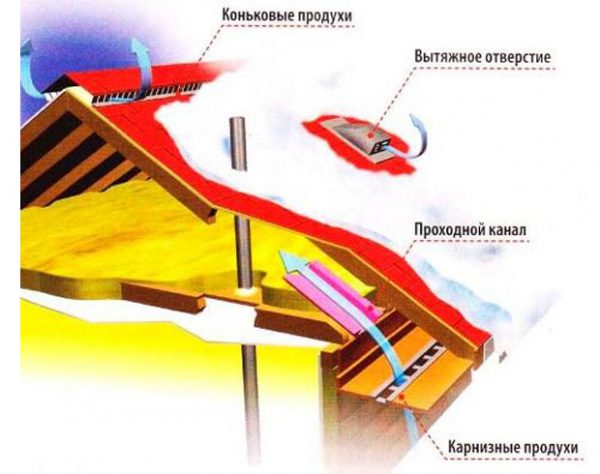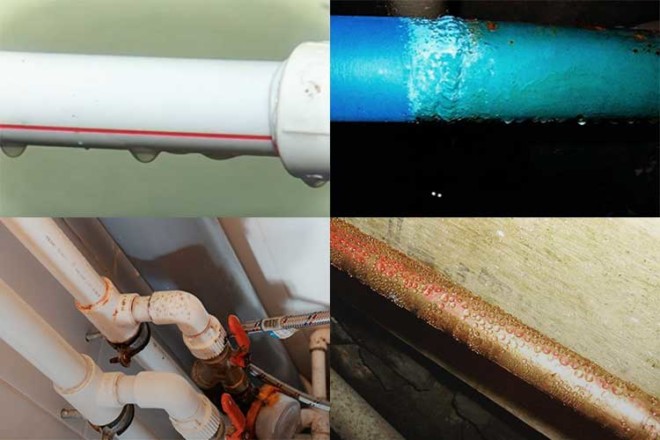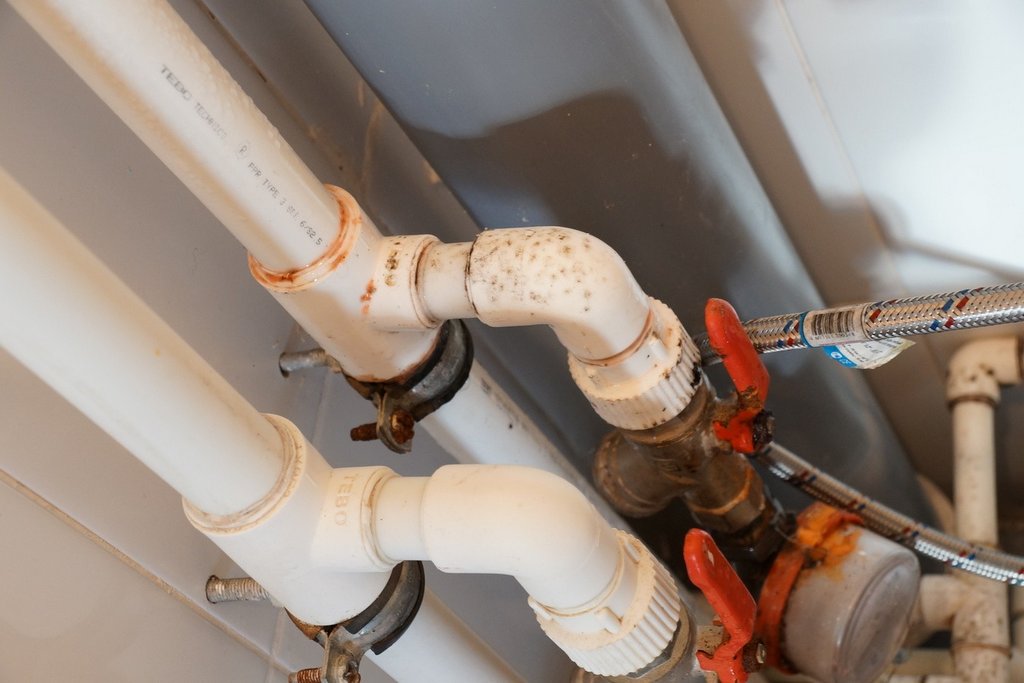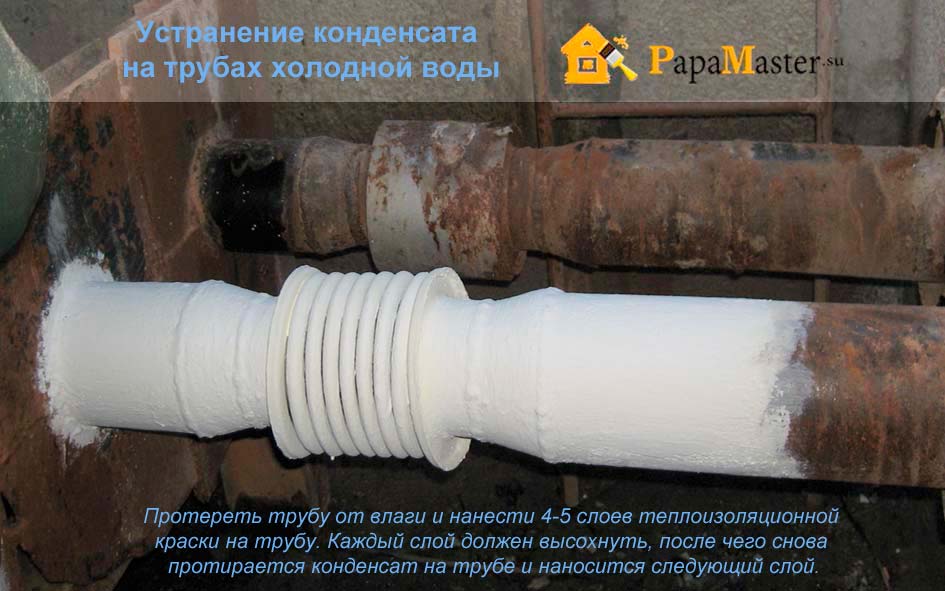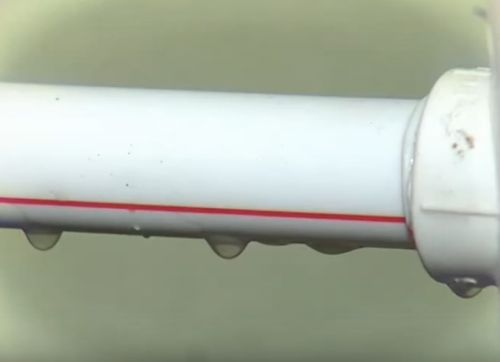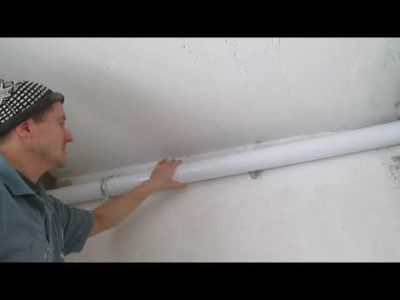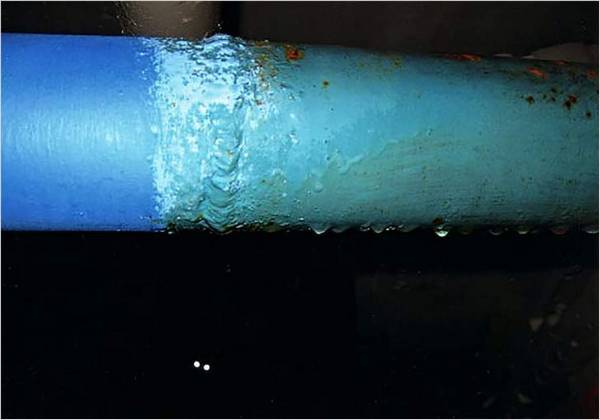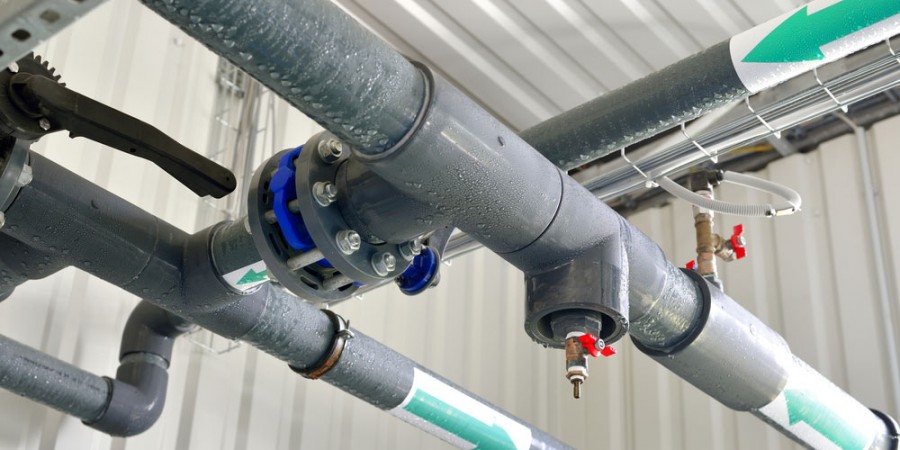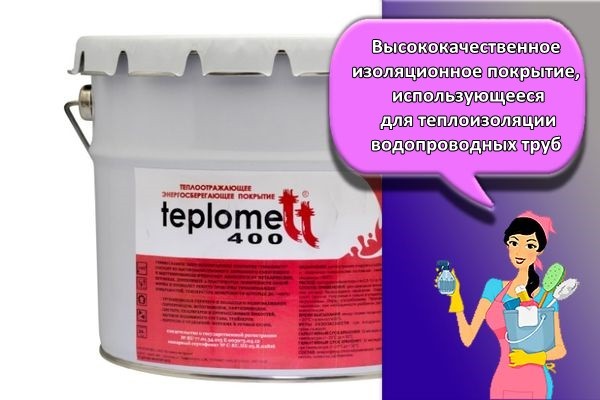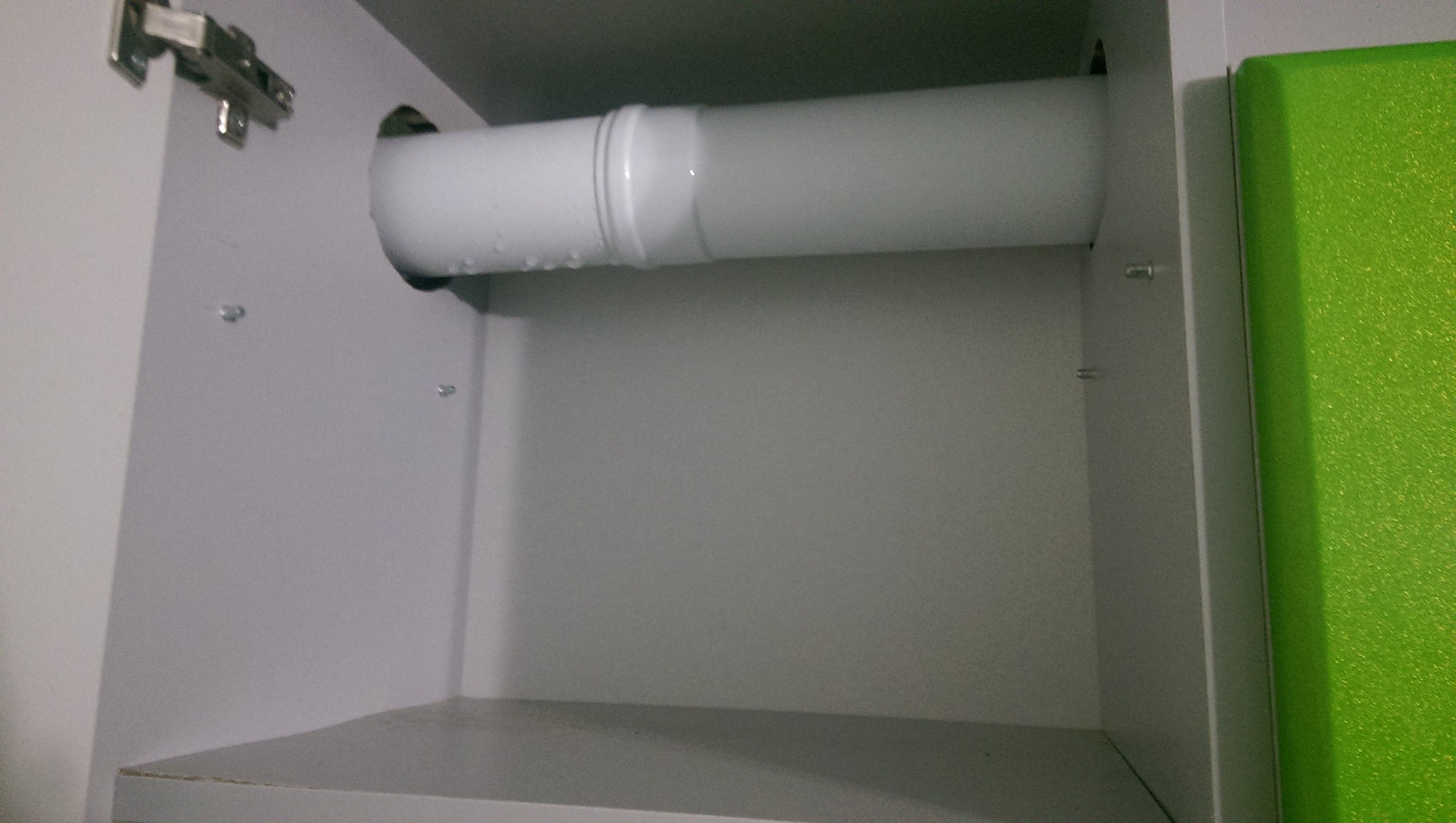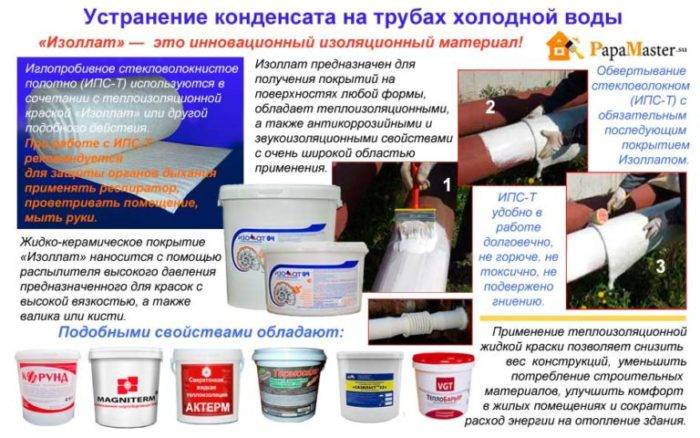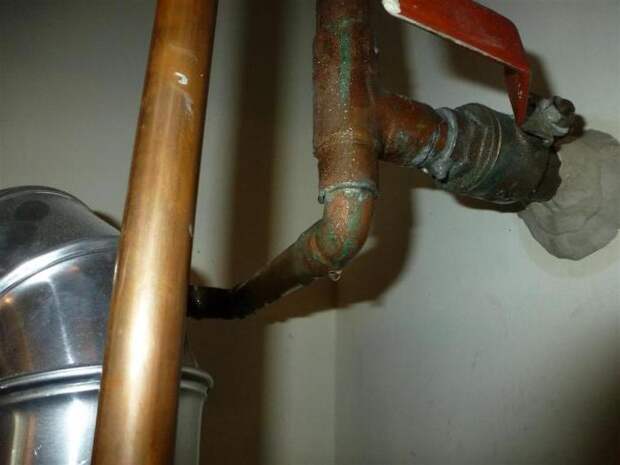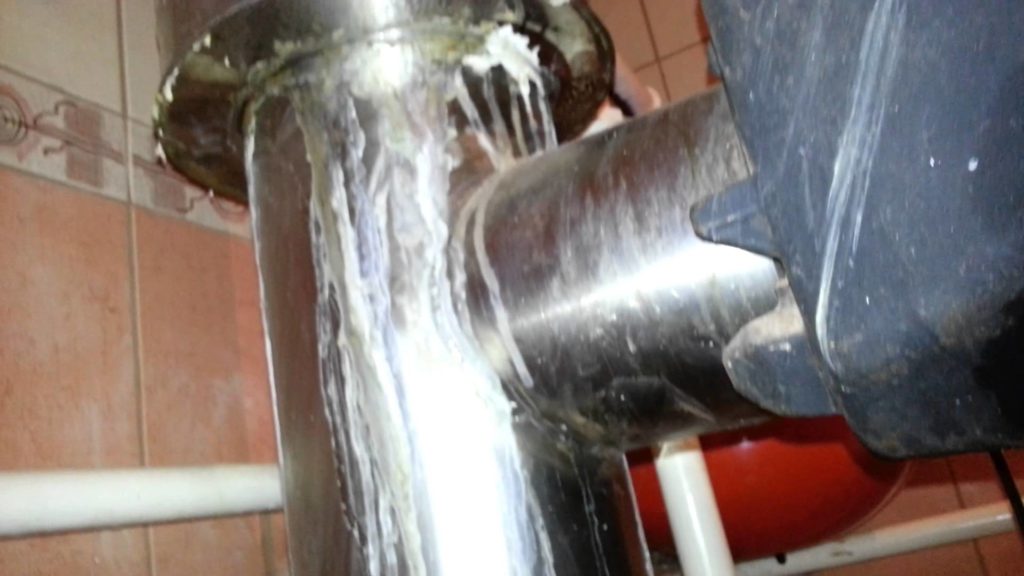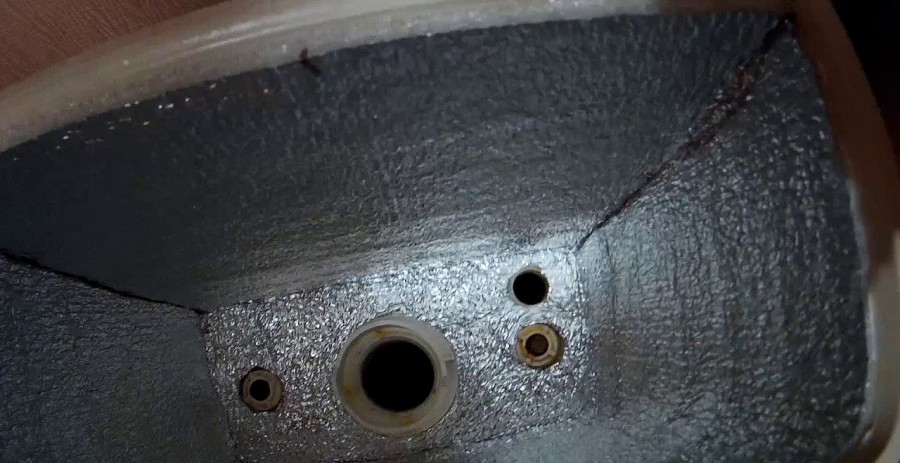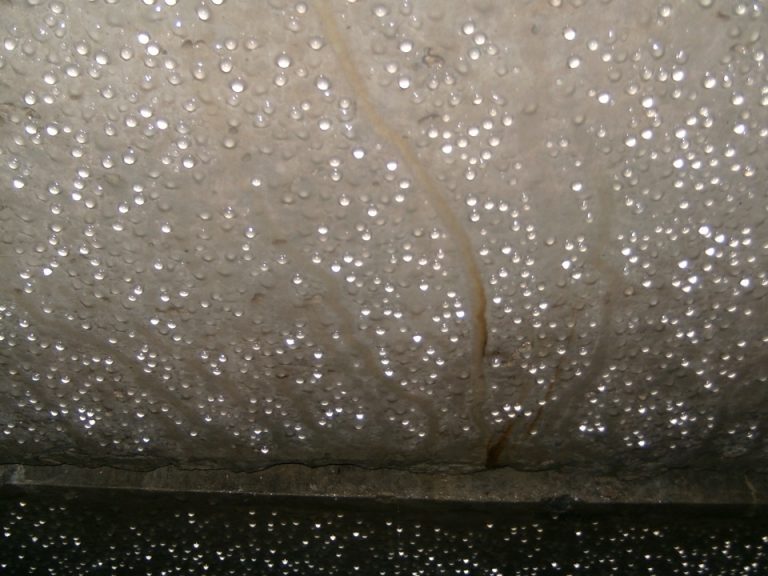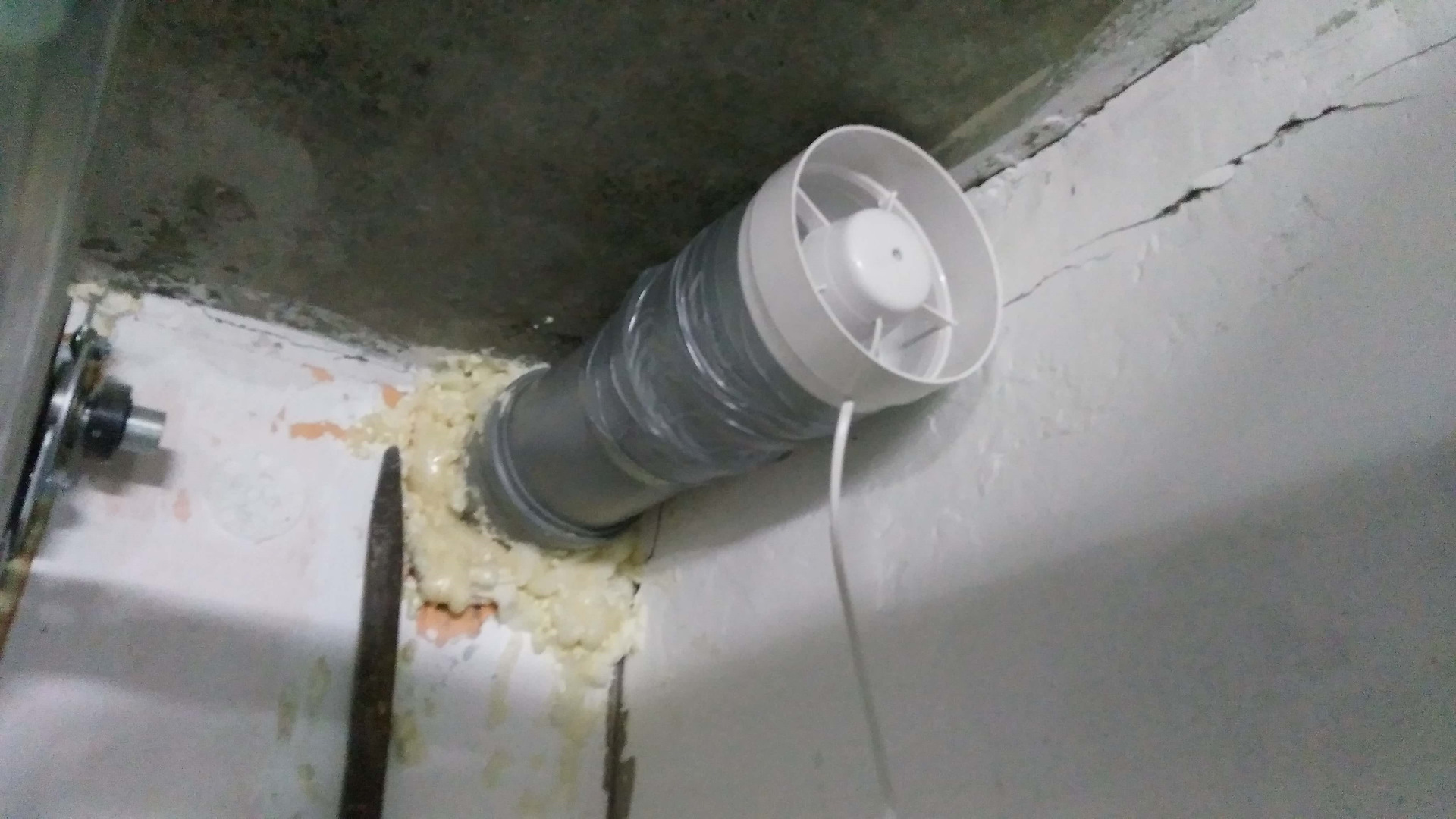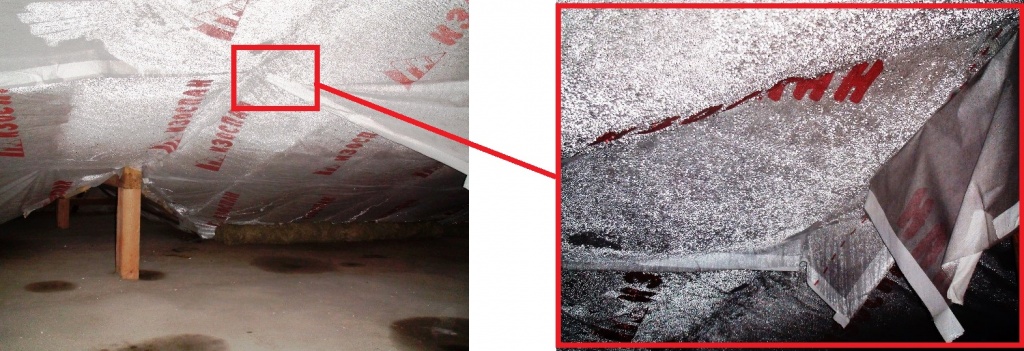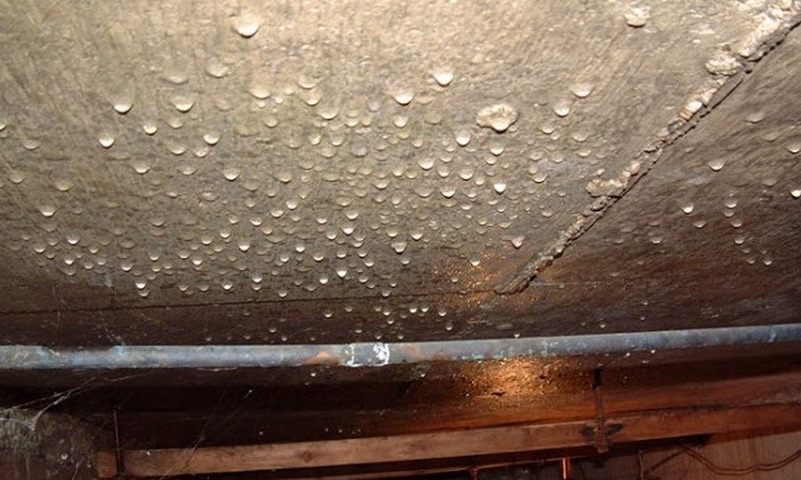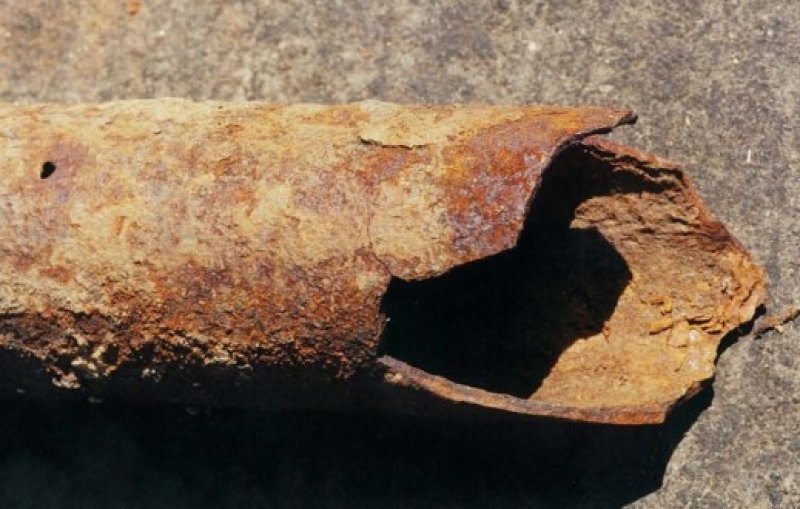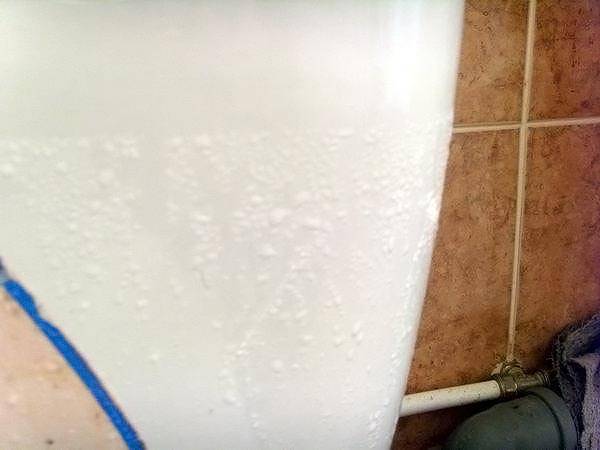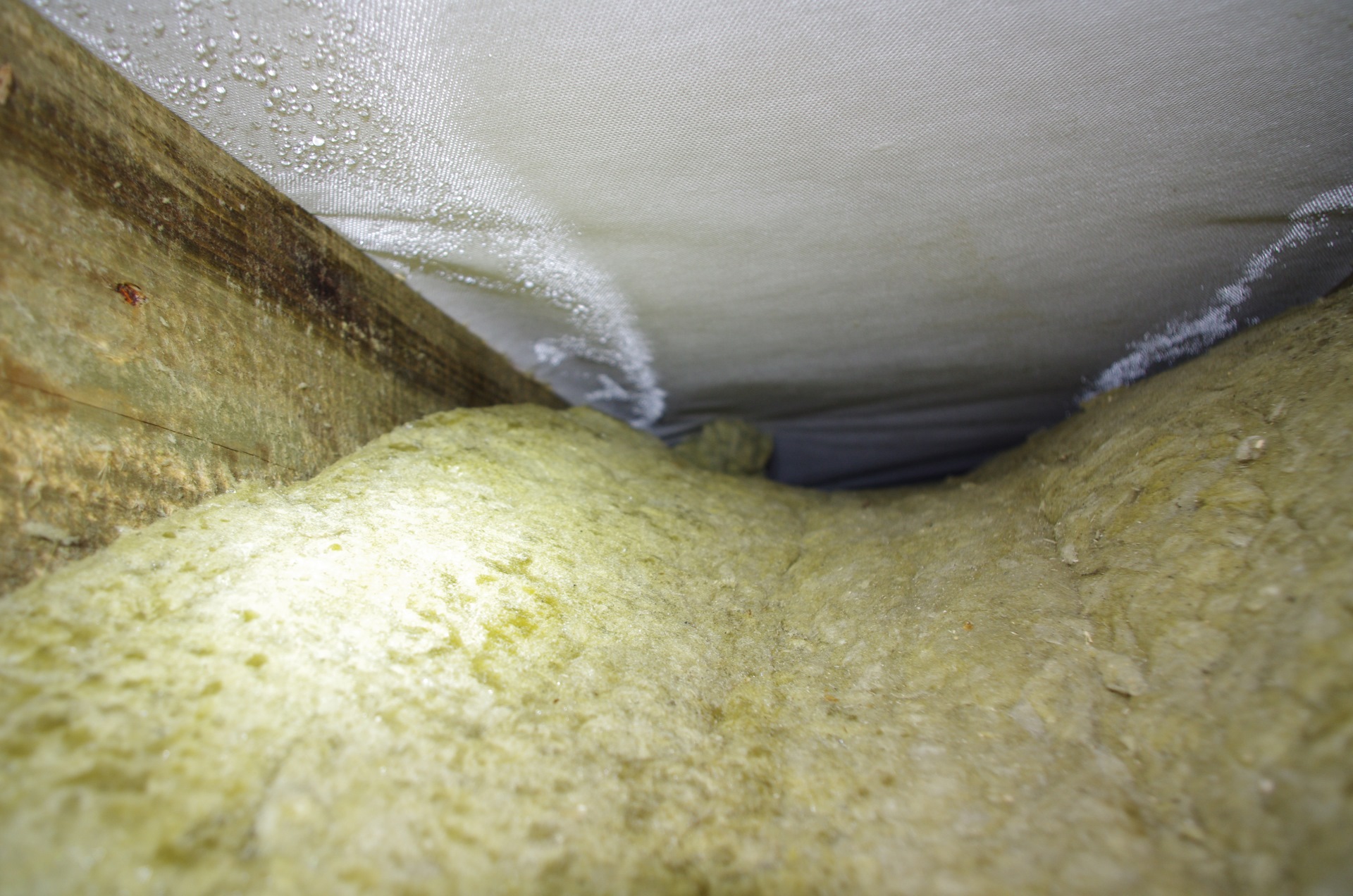Use of special tools

Many different materials are used as insulating material to protect pipes from condensation, depending on the specific situation.
The easiest way to use pads is made of foam. They look like soft pipes with a longitudinal section
It is important to select the correct size so that there is no space left between the material and the pipes.
A very effective method, but also more expensive, is the use of insulating paint. To properly insulate the pipes, it will need to be applied in about 5 layers, while allowing each layer to dry.

In addition, plastic overlays are also used for decoration. In this case, the distance that forms inside these elements will need to be filled with ordinary polyurethane foam.
Please note: before the start of the insulation work, you must not forget about the need for preliminary drying, because you cannot insulate wet pipes.
All of the above methods for solving the problem of "sweating" are the most effective. However, if you do not have the required amount of money to purchase such expensive coatings, you can even make thermal insulation with your own hands. It is also possible to use Grafotherm chemicals, which will help eliminate fogging at any temperature.
How to deal with the effects of temperature fluctuations
To minimize the effect of the temperature difference, it is necessary to insulate the cold water supply line. This can be done in several ways.
Materials for thermal insulation
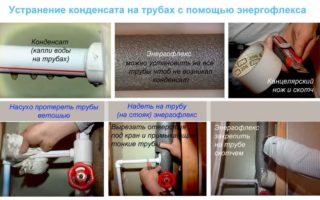 The easiest way to use these types of insulating building materials:
The easiest way to use these types of insulating building materials:
- Expanded polystyrene. It is considered a universal insulating building material for polymer plumbing. It is produced in the form of a shell, which consists of two halves. Installing a heat insulator is pretty straightforward. Half the shells cover the pipe and fasten it with tape.
- Mineral wool for thermal insulation is sold in rolls. She is simply wrapped around the pipes, creating a protective casing.
- Polyurethane foam is characterized by increased insulating performance. It is applied to products during manufacture in a layer up to 50 millimeters thick.
- Foamed polyethylene - energoflex is produced in the form of cases that can be easily put on pipe sections. Longitudinal seams are glued or fastened with clamps.
Another option for insulation is a plastic pipe with a large section, which is put on the main one. The resulting gap is filled with polyurethane foam. When performing any work on the insulation of the pipeline, it will be necessary to completely dry the surface from the condensate that has appeared.
Insulating compounds
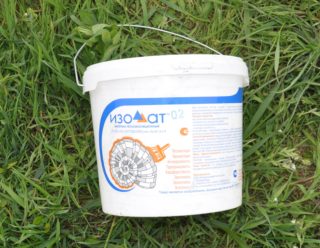 Isollat, a special paint for pipe insulation, helps to avoid condensation. This is an aqueous emulsion that, after drying, turns into a polymer "cover" with the effect of a thermos. The coating has excellent thermal insulation properties.
Isollat, a special paint for pipe insulation, helps to avoid condensation. This is an aqueous emulsion that, after drying, turns into a polymer "cover" with the effect of a thermos. The coating has excellent thermal insulation properties.
To get rid of moisture droplets, the surface of the pipeline is treated with chemical compounds: "Stermizol", "Corundum", "Teplomett".
Correct application of insulating compounds:
- Clean the surface of the water supply system from dirt and rust.
- Apply a layer of adhesion primer and leave to dry.
- Using a roller, brush or spray, coat the surface with the mixture, preferably five coats. Each will take an hour to dry.
The service life of the water pipe covered with a heat insulator can be increased by a special fixer, which simultaneously gives decorative appeal.
Thermal insulation of the line also helps if the piping elements are located next to each other.
What to do if pipe fogging is detected
If you notice in the bathroom that the riser or other pipes related to the cold water supply are covered with small drops of water, then a series of actions should be taken to find out the cause. Our algorithm will help you:
- First you have to inspect the ventilation grill and check the entire system for operability. To do this, you need to bring a sheet of paper to the grate and slightly open the window. If the paper sticks to the hole, then the ventilation is working properly, otherwise it is necessary to identify the causes of the malfunction in the operation of the entire exhaust system. If the bathroom is equipped with a forced electric fan, you need to start it up and observe the pipe. If the drops remain and do not dry out, then the reason is different.
- Next, we head to the stopcocks, mixers and the tank drain system. Failures in these segments can be seen with the naked eye. Sometimes the solution to the problem is to fix the leak. It is necessary to repair or replace the faucets and adjust the float in the toilet cistern so that the water does not leak out on its own.
- The problem may not be in your apartment, but in the riser on top. Here you will have to go through the neighbors and check for a leak in the central cold water supply pipe.
Important! If all faults in the water supply system have been eliminated, ventilation is working correctly, then the appearance of moisture is due to the temperature difference. Installing new windows or additional heating systems will definitely affect the room temperature.
If the temperature difference between the water in the pipe and the air in the room is more than 17 ° C, then condensation will certainly appear
The installation of new windows or additional heating systems will definitely affect the room temperature. If the temperature difference between the water in the pipe and the air in the room is more than 17 ° C, then condensation will certainly appear.
Danger of condensation
A well-made and hermetically installed double-glazed window is a guarantee of comfortable heat in an apartment or a private house. However, such a window blocks the access of fresh air to the room, violates the microclimate that is favorable for humans inside it. And condensation on plastic windows just indicates a violation of the microclimate in the home. High humidity actively promotes the reproduction of harmful bacteria in the house, the formation of fungus, mold.
The optimal conditions, according to SNIP 2.04.05-91, are:
- temperature 20-22 ° C;
- and moisture content 30-45%.
The risk of fogging the windows then becomes minimal. And as soon as the double-glazed windows still began to "sweat", then there is a violation of the favorable climate in the room.
Reasons for the formation of condensation on pipes

The key factors for moisture build-up on pipes are:
- the presence of a source of high humidity;
- poor quality pipe insulation;
- poor ventilation;
- temperature drops.
Condensation is especially noticeable in summer. It can drain from cold pipes, forming puddles. Pipe fogging can be caused by any of the reasons. But more often the problem arises when these conditions are combined.
With regard to high humidity, its source can be:
- steam from cooking in the kitchen;
- evaporation from hanging wet items after washing;
- pipeline breakdowns or leaking pipes in the basement;
- clogged ventilation;
- violation of building construction technology;
- climate features;
- the presence of large bodies of water nearby.
More often, condensation appears on the pipes in the bathroom. In the bathroom, it can be caused by poor ventilation of the room, leakage or pipes from neighbors.
Condensation in the toilet is facilitated by the leakage of the cistern. The water in the pipe does not have time to warm up, it is constantly replaced by cold water.The pipe cools down even more. In such cases, it is required to repair the drain tank and check the serviceability of all taps.
Physical pipe insulation
Excessive moisture can also be eliminated with the help of special insulating materials, the range of which is presented:
- foam;
- basalt;
- foamed polyethylene;
- mineral wool.
Insulation material is produced in rolls that are installed around the insulated pipe. The roll has three components:
- the actual insulation;
- protective layer;
- glue base - is not an obligatory component, it may be absent on some products.
It is not difficult to install the insulation yourself. When choosing a roll, it should be borne in mind that its diameter must be comparable to the diameter of the pipeline, otherwise the insulation will not fit snugly to the pipe and moisture will accumulate under it. The procedure for the physical insulation process is as follows:
- cleaning the pipe surface from dirt and rust;
- removing the protective film from the adhesive base of the roll or applying adhesive to the pipe for insulating material;
- installation of a roll around the pipeline - the first should be firmly pressed against the last, this will ensure high-quality adhesion of surfaces;
- gluing the longitudinal hole of the roll.
Causes of condensation and remedies
Causes of moisture
If condensate accumulates on a pipe with cold water, in order to figure out how to fix the problem, you need to identify the main causes of this phenomenon. There are several reasons for the accumulation of moisture on pipes:
condensation on pipes in a toilet or bathroom can be the result of a malfunctioning plumbing or water taps. If cold water is constantly leaking in some place, this leads to the renewal of the liquid in the pipe. Consequently, the temperature of the water in the pipe is at its minimum value. A drop occurs and condensation forms on the cold pipe;
Leakage of water from the taps
- if condensate predominantly accumulates on the water supply pipes of the riser in the bathroom or sewage system, then the problem with the formation of a leak may be with the neighbors living on the floor above;
- poor ventilation in the room. The reason for the lack of air movement may be clogging of the ventilation duct or metal-plastic windows, which, when closed, do not allow air to pass from the outside. With poor ventilation, water vapor accumulates in a residential area, which subsequently settles on plastic pipes (metal pipes, and so on). You can check the presence of efficient ventilation with a match or a lighter. The flame from any object should be "drawn" into the hood. If this effect does not occur, then the channel is either clogged or unable to cope with its task.
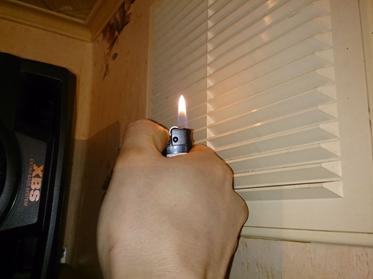
Method of checking the ventilation duct for operability
If moisture is detected on pipes, it is recommended to identify and eliminate the causes of its appearance as soon as possible.
Elimination of leaks
Why condensation forms on the pipes, they found out. Now let's figure out how to fix leaks.
First of all, it is required to determine the place where the water leakage occurs. The leak can be:
- due to faulty taps or mixer. In this situation, water will drip from the tap;
- after a pipe break;
- due to deterioration of fittings on polypropylene pipes (metal-plastic pipes).
It is most difficult to detect pipe breaks or worn fittings if the pipes are hidden in the wall. To detect a leak, you will need to partially disassemble the box covering the pipes, or resort to the help of specialists who will identify the malfunction with special devices - thermal imagers. Both the one and the other methods will entail significant cash costs.
If a leak is detected in a mixer or tap, then you can:
- change all gaskets.You can purchase a faucet repair kit at any specialist store. To select a repair kit, you need to know the brand and manufacturer of the mixer. You can replace the gaskets yourself;
Faucet DIY Repair Kit
- if after the repair the formation of condensation on the pipes has not stopped, then the mixer must be replaced.
If a leak is detected in the pipes, then you can:
-
replace the problem section of the pipe with a new elbow. To do this, you will need to carefully cut the leaking cut and install a new pipe. Everything is quite simple if non-metal pipes are installed in the room. When using metal pipes, special equipment will be required. For help, you can contact plumbers or a management company, who are obliged to eliminate the malfunction as soon as possible;
- solder the pipe, that is, install the plug in the place of the leak. This method is considered the least reliable, therefore it is recommended to use it as a temporary measure.
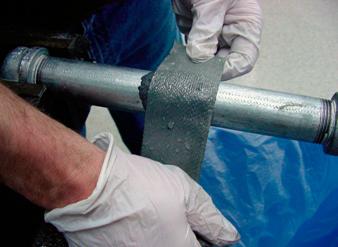
Pipe restoration without replacement
Replacing the fittings is not a problem. It is enough to remove the leaking part and install a similar new product.
Before carrying out any operation, it is required to first shut off the water supply of the living quarters.
Troubleshooting ventilation problems
How to get rid of condensation on the pipes, if the reason lies in insufficient ventilation of the room? Required:
- contact the management company with a request to inspect and clean the ventilation shaft of the house. The specified work should be done free of charge and in a short time, since monitoring the technical condition of the house is the direct responsibility of managers;
- what to do if the problems in the mine of the house are eliminated, but condensate still accumulates. Can be installed in bath, toilet, etc. additional fan built into the hood. The fan can be turned on forcibly or work, for example, when the light is turned on;
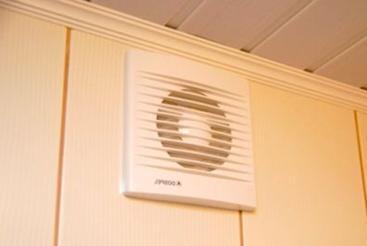
An additional device that increases the performance of the hood
- You can get rid of condensation on a cold pipe by installing an air conditioner or a kitchen hood for a stove or gas water heater.
Methods for eliminating window condensation
To remove the condensation that appears on the window, you need:
- quickly ventilate the room;
- put a thick burning candle on the windowsill (that is, provide air convection);
- turn on the fan, creating a movable air flow near the window;
- use convection screens (special plates that direct warm air flow from heating radiators to windows);
- apply automotive chemicals (anti-fogging sprays) to treat double-glazed windows;
- use electricity, that is, lay foil tape, nitrochrome thread or conductive film operating under voltage (12V-24V) around the window perimeter;
- use supply ventilation valves designed to maintain optimal air exchange in the room.
Reasons for education
Before getting rid of condensation, you need to familiarize yourself with the main causes of its occurrence.
High humidity source
There are several sources of increased humidity levels, due to which water droplets appear on the pipes.
Cooking
Cooking is a common cause of increased humidity. A lot of steam is generated during the cooking process. If there is a weak hood in the kitchen that does not cope with the removal of the resulting fumes, the steam settles on the surfaces and condensation appears.
Wet linen
Experts recommend drying your washed items outside. However, in winter, some decide to dry them in an apartment. Wet laundry emits cold steam after washing, which gradually accumulates in the room.
Water supply failure
Vapors from wet laundry and cooking food are not the only ones that cause condensation to form on water pipes. There are other reasons for this problem as well. One of them is an accident and irregularities in the operation of the water supply system.
Basement flooding
Flooding in the basement is a common cause of increased humidity. Most often it is flooded due to poor-quality basement waterproofing. Unprotected walls are destroyed by the influence of groundwater, which gradually penetrates inside.
Building defect
There are several defects that contribute to the appearance of dampness and moisture on the pipes. These include:
- cracking walls;
- the inclination of the walls relative to the vertical axis;
- lamination of masonry;
- crumbling of external bricks;
- freezing of the walls and the appearance of icing on their surface;
- shrinkage of the walls.
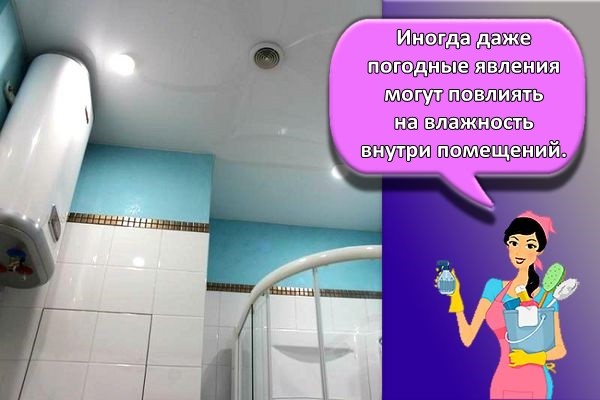
Geographical features of the area
Popular reasons for the appearance of condensation on the iron surface of pipes include the geographical features of the area in which the residential building is located. Among such features, the close location of rivers or lakes is distinguished, due to which the level of humidity increases significantly.
Unfavorable weather conditions
Sometimes even weather conditions can affect indoor humidity. Severe weather conditions include prolonged showers and sleet in combination with increased gusts of wind.
Poor ventilation
Poor ventilation is a common cause of condensation on water pipes. Residents of apartments with non-opening plastic windows face poor ventilation. With the windows closed, the ventilation system works several times worse.
Poor thermal insulation
Some people do not think about the thermal insulation of a residential building or apartment, and because of this, condensation can be noticed in the room.
Sharp temperature drop
A sharp fluctuation in temperature indicators in an apartment contributes to the formation of water droplets on the pipes. Temperature drops appear due to poor-quality heating or poor thermal insulation, which is not able to retain heat.

What else can you get rid of condensation
From ready-made chemicals help Korund, Teplomett, Stermisol. These insulating mixtures should be used to cover pipes cleaned from dirt. If we assume that there will be at least 5-6 layers, and the can costs at least 300 rubles and it is enough for 1-2 layers, the price of the issue confuses. Chemical insulation is useful where other material cannot be laid out due to the thickness of the sheets.
steam trap
The thing is very useful when there is a water heater at home. The condenser drain is installed at the outlet of the water heater, it copes with the removal of moisture by itself. I think I'll put one in the bathroom on a hot water heater - we turn it on in the summer when there is no hot water.
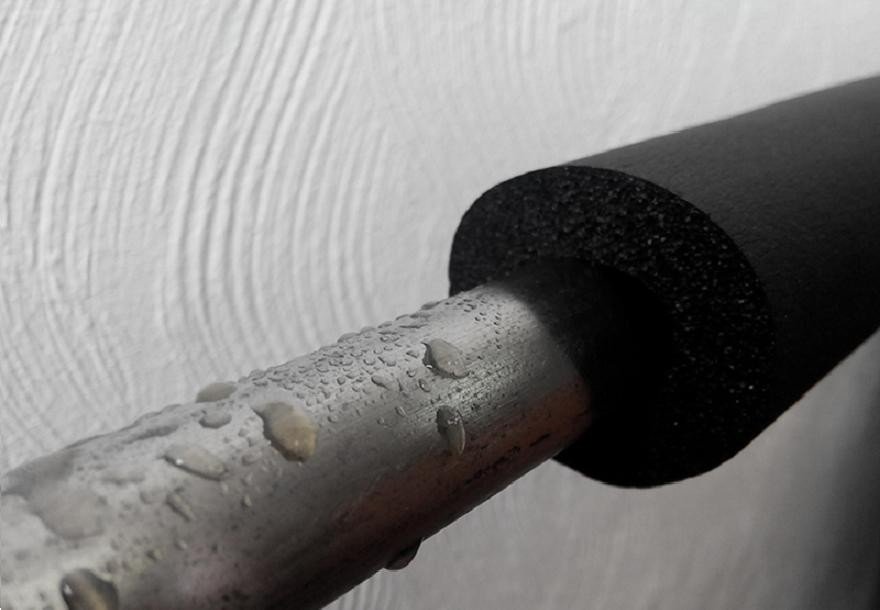
I will take a float steam trap. It is easier to install, cheaper, there is nothing to break in it, because it is just suitable for domestic use. There are also thermostatic and combined ones, but they are more expensive, and they are installed when there is a water heater, air heaters and other heaters at home.
So, if moisture appears on the pipes, check:
- ventilation;
- float in the toilet cistern;
- leakage in taps, pipes;
- neighbors from above;
- the width of the gap between the hot and cold water pipes.
Expert opinion
Vladislav Ponomarev
Design engineer, inventor
You can leave the condensation alone, but then mold will appear in the bathroom, and the constant smell of moisture will also not add comfort.
How to solve this problem
And she deserves special attention. You can purchase special material that can be easily purchased at any hardware store for little money.
It doesn't matter if this is not at hand, you can use the means at hand. Foam and corrugation can save the day.
The corrugation is pre-cut into the desired pieces, and they are put on the pipes.The empty space is filled with polyurethane foam. On this, the mission is considered completed.
Video
There is another very simple method that will help eliminate the appearance of water droplets on the pipes. For work you need to prepare:
- sanding paper;
- phosphoric acid;
- thick thread;
- strips of old fabric;
- putty knife;
- acetone.
Course of action:
- Any pieces of unnecessary fabric are cut into strips no more than 7 cm wide, which are rolled up. They are recommended to be prepared with a margin so as not to be distracted during work.
- The pipe is plastered, otherwise the material will not firmly adhere to it. Then it is degreased with acetone.
- At this stage, a rust converter is applied, and when the pipes dry, putty is applied to them. This material instantly hardens, for this reason, you will have to act quickly.
- The prepared pipes are wrapped with fabric strips, so that each subsequent turn goes over the previous one. The final coup is tied tightly with a cord.
- Thus, the fabric strip insulation is applied in several layers.
- The procedure is completed by applying an epoxy layer. When it dries completely, the pipe products are sanded and paint of the selected shade is applied.
How to get rid of condensation on pipes
You need to start with the simplest thing - remove sources of high humidity in a particular room, where condensation constantly occurs.
Exclude active evaporation when boiling water (use tight-fitting lids). If you do only this, then there will already be much less reasons for the appearance of condensation. For example, do not hang out wet (washed) laundry next to a ventilation or water pipe.
In the event that the usual precautions do not give positive results, it is necessary to come to grips with ventilation. In apartment buildings, it is envisaged by the project for the construction of a house - ventilation shafts and pipes have been laid. If there is not enough draft (there is no air movement) in the ventilation pipe (box), then the communication is blocked (clogged) by some object, or simply accumulated dust and it must be cleaned
If there is not enough draft (there is no air movement) in the ventilation pipe (box), then the communication is blocked (clogged) by some object, or simply accumulated dust and must be cleaned.
For complete confidence in the performance of the ventilation system, you should install fans specially designed to forcefully influence the movement of air flows.
For private houses, if there is no ventilation system for rooms with unexpected high humidity, you will have to install it.
Without this addition, the humidity will remain at the same level.
With regard to stove and ventilation pipes, on which condensed moisture can also form, it is necessary to bring them into working condition corresponding to the correct performance of their working functions.
So for the chimney (chimney) the temperature of the smoke passing through it is very important. If it is not high enough, moisture will form and accumulate, which will lead to the need to repair or replace the entire smoke extraction system.
That is, so that condensation does not occur, you need to make the stove such that the temperature of the smoke coming out of it is high enough (230 or more degrees).
For ventilation systems, the opposite is true. Sufficiently cooled air should get there. For this, kitchen hoods are installed directly above the stove.
They not only catch the smells of cooking food (many believe that this is their purpose), but, due to their large surface, they effectively take away the heat that the stove or oven gives.
What to do if condensation appears on the cold water pipes?
There are times when everything is in order with ventilation, but in the room, for example, in the bathroom, there is periodically a large temperature difference between the pipes and their environment.
This happens when there are people in the house who like to take a very hot shower. In this case, a large amount of steam is formed, which, in contact with the pipes, falls on them in the form of condensate.
This phenomenon can be overcome in only one way - to use heat-insulating materials, with which it is necessary to close the pipes from contact with the environment.
There are several options on sale:
- mineral wool mats coated with aluminum foil;
- tubes made of porous materials (rubber, polystyrene, polystyrene).
In the first case, the problem pipe is wrapped with this material, followed by fixation. In the second, the tubes are cut lengthwise and put on the weeping tube.
Their inner diameter is easy to select for the desired section, as this is provided by the manufacturers and almost all standard sizes are available for sale.
Old methods of dealing with condensation, such as desiccant bags (silica gel), which are sent to dry as they get wet, or gauze with the free end lowered into a jar to collect water, are outdated. They can only be used to temporarily solve the problem.
Why is condensate on pipes dangerous?
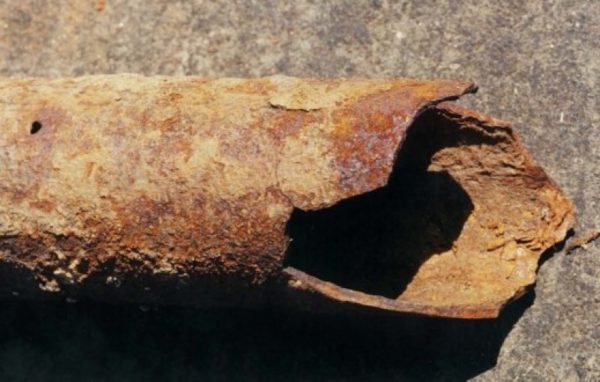 Condensation promotes metal corrosion
Condensation promotes metal corrosion
Water droplets on the surface of pipes are not a minor household nuisance. At first, the owners will have to constantly wipe or scoop out the liquid, but over time, the condition of the bathroom will only get worse. High humidity causes a persistent damp odor and creates a favorable environment for the development of fungi and mold. Their spores fly through the air and enter the respiratory tract, which can cause serious illness.
Moisture on metal pipes creates an aggressive environment, promotes corrosion of the material and the rapid failure of communications. Water does no less harm to floor and wall coverings - they begin to crack and lag behind, and sooner or later the bathroom will have to be overhauled. If the liquid seeps out to the neighbors, which happens quite often, two rooms will have to be tidied up at once.
The financial costs of condensate formation can be associated not only with repair work, but also with utility bills. If there are leaks in the tank or faucet, owners will have to pay for the water that goes nowhere. At first, the difference may be minimal, but in a few months an impressive amount will "drip". There is only one way out of the situation - to start solving the problem of condensate immediately after it appears on the surface of the pipes.
DIY thermal insulation
It is not so difficult to make insulation for the cold water riser yourself. For this we need:
- sandpaper;
- rust converter (eg phosphoric acid);
- strong thread;
- cotton fabric (old things can be used);
- epoxy putty;
- putty knife.
An old sheet or duvet cover works well as insulation. A variety of bandages and other materials can be used. Large and wide canvases are best cut into strips up to 10 cm wide and rolled into rolls.
Next, you need to clean the pipe itself and degrease the surface. A regular acetone-based nail polish remover can do this. The next step is to treat the riser with a rust conversion agent.
After careful preparation, insulation can begin. Apply a layer of putty and, without waiting for it to dry, tightly wrap the pipe with a cloth from bottom to top. Wrap the fabric so that each turn overlaps the previous one and is saturated with putty. At the end, secure the bandage tightly with thread.
After drying, apply several more layers of insulation. The final step will be to coat the pipe with putty.When the homemade casing is completely dry and solid, it can be sanded and painted to match the wall.
Do not ignore the problem of high humidity. Not only the appearance of your bathroom depends on this, but also the integrity of the cold water supply pipes.
Causes and consequences of condensation on the pipe
In the bathroom, condensation is most likely due to temperature changes and high humidity that occurs during bathing or showering.
As for the toilet, there is most likely a leak from the toilet cistern. As a result of the constant replacement of water, its temperature remains significantly lower than the ambient temperature, which leads to cooling of the walls of the tank, which results in a temperature drop and the appearance of condensation on the pipes.
The consequences of drops not eliminated in a timely manner, both for the water supply system and for the sewage system, can be very deplorable.
First of all, the downward flow of droplets under the influence of gravity leads to the creation of favorable conditions at the base for the formation of various fungi and mold. With increased dampness, bacteria and molds will actively increase the population, so that it will be far from easy to destroy them later.
Metal pipes of cold water supply, in contact with drops, intensively rust, plastic and polypropylene lose their attractive appearance. The constant presence of dew drops adversely affects all types of finishing materials.
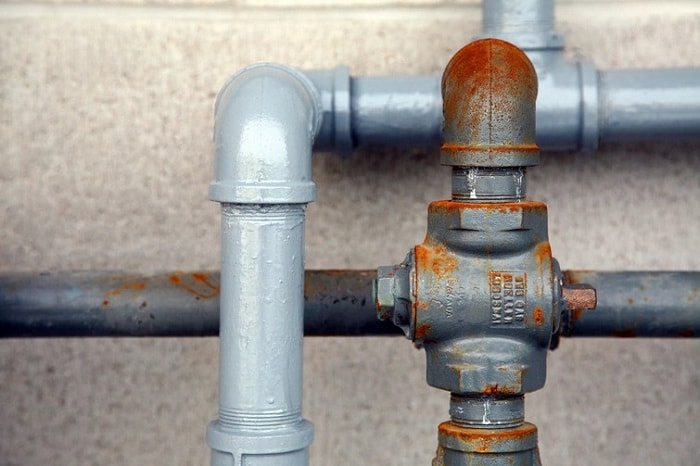
Regular flowing to the base of the pipe, of course, will not cause a natural flood in the apartment, but the water wears away the stone and sooner or later certain problems will arise there, which is unlikely to have a beneficial effect on good neighborly relations. In addition, the accumulated condensation at the base of the pipes, with a high degree of probability, will make floor covering such as laminate or linoleum unusable.
As can be seen from the above, the consequences of an untimely reaction to the presence of condensate on pipes can be quite serious, therefore, we will consider possible methods for preventing its occurrence. The fact is that prevention is cheaper than elimination of damage caused by this unpleasant phenomenon.
What to do if it appears?
The most effective methods of struggle will be the options for installing a sealed cutoff on pipes, or stopping the excessively active movement of water along the cold water supply lines. Let's consider the possible options.
On a metal pipeline
Various cut-off options are used to eliminate condensation on metal pipes. The task is to isolate the cold surface from the steam-saturated indoor air.
Different methods are used:
- The surface of the pipe is wrapped with synthetic fabric in several layers, between which a layer of epoxy putty is applied. The procedure is laborious and time-consuming, but with good results.
- Standard installation of a heat insulator (glass wool, slag wool, etc.) followed by the installation of an impenetrable protective sheet. This method is good for large pipelines installed in basements or utility rooms.
- Installation of foam or polyurethane foam shells. This is the simplest and most effective way to insulate metal pipes. A shell is a type of heat insulator in the form of a hose or two halves, which are put on the pipe and firmly fixed on it. It is necessary to completely eliminate cracks or gaps, to ensure complete tightness of the surface.
On a plastic pipeline
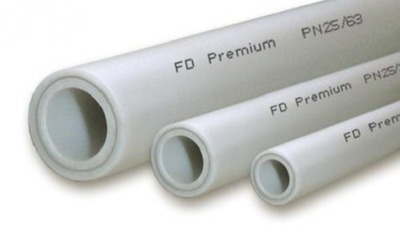 Plastic pipes do not attract condensate too much, but the danger cannot be completely ruled out.
Plastic pipes do not attract condensate too much, but the danger cannot be completely ruled out.
Therefore, to protect against moisture, you should use thermal insulation made of ready-made profile elements (shells) or a roll heat insulator.
The first option is more convenient, since it is not easy to wrap a pipe with insulation next to a wall and other communications.
Another way to protect plastic pipes is to install a protective box that completely cuts off the contact between the pipe and humid air.
It is necessary to ensure tightness, no cracks or holes. Pipeline outlet sections are insulated with pieces of foam rubber, polyurethane foam or other soft and water-impermeable materials.
On the riser
The riser is protected from condensate based on the material and the location of the pipe. Usually, several methods are used at once - they cover the surface with a heat insulator and assemble a protective sealed box.
Reference! These measures give quite effective results. The main task is the careful and thorough assembly of the insulation and the box, the complete absence of gaps or open areas.
Insulation of water pipes
Insulation can be done using an insulating pipe with a cut for easy installation on the pipeline. Before proceeding with the installation of the product, thoroughly wipe and dry the piping. This method is the simplest and fastest. Its essence is simple: elimination of sudden temperature changes.
If you are not looking for easy ways, you can carry out complete thermal insulation, which also helps to eliminate condensation. For work you will need: sanding paper, strips of cloth 5-6 cm wide, rust converter, spatula, strong thread, acetone and epoxy putty. Work algorithm:
- The water pipe is plastered in order to increase the adhesion strength;
- By means of a cloth soaked in acetone, the pipeline is degreased;
- The product is treated with a rust converter;
- We are waiting for the drying of the pipeline for some time. Then we apply a thick epoxy putty to it;
- The water pipe is quickly wrapped with cloth, the edge of which is fixed by means of a strong thread;
- Similarly, 2-3 layers of material insulation are applied;
- Apply epoxy putty again;
- We are waiting for all the layers to dry. Then the pipeline is sanded and painted.
Additional ways to eliminate condensation
- A corrugation with a large diameter is bought. The cavity between it and the pipeline is filled with polyurethane foam. The method is optimal for working with a riser;
- In specialized stores, you can look for the composition of "Grafotherm". Its principle of operation is simple: the product forms a thin but durable film that prevents condensation;
- If the cause of this problem is a slight water leak, it is necessary to replace or repair the taps or the inlet valve of the drain tank;
- In the event that water droplets appear on the riser, it may not be you who are to blame for the problem, but the neighbors from above. Accordingly, this is an excellent excuse to descend upon them with a friendly visit;
- The easiest way to eliminate condensation is to wrap the water pipes with cloth or bandages. The method is good only for temporary getting rid of the problem;
- Be sure to check the quality of ventilation in the bathroom and toilet. This factor also influences the formation of water droplets. It is recommended to install an exhaust fan if necessary;
- Insulation from water pipes transporting cold water is carried out by means of special pipes made of various materials (foamed polyethylene, energy flex, and so on). It is enough to cut these products along the entire length, install them over the pipeline, fixing them with metallized permanent tape. This measure allows you to eliminate temperature drops, temperature drops at which surfaces fog up, and then drops of water begin to flow from them to the floor.
If you've tried everything and the condensation doesn't seem to disappear, the problem is probably more serious. Perhaps the difficulty lies in the poor waterproofing of the walls or floor. Redecoration is not enough here. It is required to determine which factor leads to an increase in humidity.These can be fumes from the basement, a damp foundation, non-professional wall insulation. Only after eliminating the source of the problem can you begin to work on high-quality insulation of the walls and ceiling.

